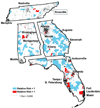Spatial patterns of localized-stage prostate cancer incidence among white and black men in the southeastern United States, 1999-2001
- PMID: 20501756
- PMCID: PMC2883026
- DOI: 10.1158/1055-9965.EPI-09-1310
Spatial patterns of localized-stage prostate cancer incidence among white and black men in the southeastern United States, 1999-2001
Abstract
Background: In the United States, prostate cancer incidence is higher among black than among white males, with a higher proportion of blacks diagnosed with advanced-stage cancer.
Methods: Prostate cancer incidence (1999-2001) and census tract data were obtained for 66,468 cases in four states that account for 20% of U.S. blacks: Georgia, Florida, Alabama, and Tennessee. Spatial clusters of localized-stage prostate cancer incidence were detected by spatial scan. Clusters were examined by relative risk, population density, and socioeconomic and racial attributes.
Results: Overall prostate cancer incidence rates were higher in black than in white men, and a lower proportion of black cases were diagnosed with localized-stage cancer. Strong associations were seen between urban residence and high relative risk of localized-stage cancer. The highest relative risks generally occurred in clusters with a lower percent black population than the national average. Conversely, of eight nonurban clusters with significantly elevated relative risk of localized-disease, seven had a higher proportion of blacks than the national average. Furthermore, positive correlations between percent black population and relative risk of localized-stage cancer were seen in Alabama and Georgia.
Conclusion: Association between urban residence and high relative risk of localized-stage disease (favorable prognosis) persisted after spatial clusters were stratified by percent black population. Unexpectedly, seven of eight nonurban clusters with high relative risk of localized-stage disease had a higher percentage of blacks than the U.S. population.
Impact: Although evidence of racial disparity in prostate cancer was found, there were some encouraging findings. Studies of community-level factors that might contribute to these findings are recommended.
Copyright 2010 AACR.
Figures


References
-
- American Cancer Society. 2006. Atlanta: American Cancer Society; Cancer facts and figures for African Americans; 2005–2006.
-
- Schwartz KL, Crossley-May H, Vigneau FD, Brown K, Banerjee M. Race, socioeconomic status and stage at diagnosis for five common malignancies. Cancer Causes Control. 2003 Oct;14(8):761–766. - PubMed
-
- Horner MJ, Ries LAG, Krapcho M, et al. SEER cancer statistics review, 1975–2006. Bethesda, MD: National Cancer Institute; 2009.
-
- Jones BA, Liu WL, Araujo AB, et al. Explaining the race difference in prostate cancer stage at diagnosis. Cancer Epidemiol Biomarkers Prev. 2008 Oct;17(10):2825–2834. - PubMed
-
- Byers TE, Wolf HJ, Bauer KR, et al. The impact of socioeconomic status on survival after cancer in the united states : Findings from the national program of cancer registries patterns of care study. Cancer. 2008 Aug 1;113(3):582–591. - PubMed
MeSH terms
Grants and funding
LinkOut - more resources
Full Text Sources
Other Literature Sources
Medical

